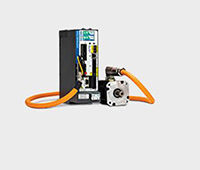
May Mobility is creating self-driving shuttles that operate in geofenced areas. (Credit: May Mobility)
May Mobility, an Ann Arbor, Mich.-based startup founded in early 2017 that’s developing self-driving shuttles, raised $11.5 million in seed investment from Toyota AI Ventures and BMW i Ventures. The self-driving shuttles are being developed for college campuses, central business districts and other low-speed, geofenced applications.
May Mobility, which has raised $11.6 million to date, ran a small pilot program in Detroit in October 2017 to test the self-driving shuttles. It said the funding will be used to launch a commercial ride-sharing service later in 2018.
Toyota AI Ventures, a venture capital subsidiary of the Toyota Research Institute (TRI) formed about one year ago, has an investment budget of $100 million. May Mobility is the seventh early-stage startup Toyota AI Ventures has invested in. The others include Connected Signals, Intuition Robotics, Joby Aviation, Nauto, Realtime Robotics, and SLAMcore. Realtime Robotics, which is working on a processor that enables real-time motion planning, is exhibiting and speaking at the Robotics Summit and Showcase.
May Mobility Self-Driving Shuttles in Geofenced Areas
May Mobility has a fleet of low-speed, electric Polaris GEM vehicles outfitted with sensors and the company’s autonomous driving software. The pilot program with Detroit-based Bedrock was a major success, showing that May Mobility’s self-driving shuttles are ready to be rolled out in geofenced areas, which is where autonomous vehicles will first be rolled out. May Mobility is tackling low-speed, pre-planned routes to help businesses, colleges, and small, underserved communities improve short-distance travel services.
During the Bedrock pilot, a self-driving shuttle ran for five nights on a one-mile loop. It picked up workers on later shifts between 7 p.m. and 10 p.m. to avoid high traffic on the streets. A few hundred workers used the shuttle during the pilot. A safety driver remained on board and intervened when necessary, though the shuttle ran on its own about 95 percent of the time.
The investment in May Mobility also is well-aligned with Toyota’s approach to autonomous vehicles. Gill Pratt, CEO of TRI, said at CES 2017 that fully autonomous vehicles operating regularly on public streets are “not even close” to being ready. “It’s going to take many years of machine learning and many, many more miles” of testing, he added.
Jim Adler, managing director of Toyota AI Ventures, reiterated those sentiments in a blog announcing the investment in May Mobility. He wrote, “When asked by reporters and other industry watchers to predict when self-driving vehicles will appear on our public roadways, my answer is generally that it will be sooner than we think, but not everywhere we’d like. Fully-autonomous Level 5 driving is still years away, where a vehicle is able to operate autonomously anywhere and in any conditions. The good news is that there are specific use cases and environments where autonomous vehicles are able to hit the roads now.”
May Mobility’s Self-Driving Team
May Mobility’s self-driving shuttle team has more than 25 years of combined robotics and automotive industry experience, with a good mix of technical- and business-savvy employees. May Mobility’s founders include CEO Ed Olson, former co-director of autonomous driving at TRI; COO Alisyn Malek, who oversaw the relationship with Cruise Automation while working at GM Ventures; and CTO Steve Vozar, a roboticist who most recently ran the University of Michigan’s (UM) APRIL robotics laboratory.
“We look to invest not just in the brightest ideas and teams in mobility, but in the best businesses,” Jim Adler, managing director of Toyota AI Ventures, said in the release. “We love that May Mobility is actively applying great technology to improve the quality of life in communities throughout the country. But it’s just as important that they’re signing paying customers that prove that the unit economics work.”
May Mobility Partnered with Cepton
In January 2018, May Mobility partnered with Cepton, a provider of 3D LiDAR solutions. May Mobility will integrate Cepton LiDAR products into its self-driving shuttles.
“We left big auto so we could have more control of when our technology would hit the road, and a partner like Cepton, who has clearly communicated expectations and demonstrated outstanding follow-through, is essential in helping us get cars on the road first,” said Olson. “Cepton is driving the high performance LiDAR evolution to break the $1,000 price point; we are very excited about our collaboration and what it will mean for the future of the industry.”
“Cepton and May Mobility are biased toward action and share a common vision that autonomous vehicles can be developed and deployed with today’s advanced technology,” said Jun Pei, Co-Founder and CEO of Cepton. “The May Mobility platform takes advantage of the latest high performance LiDAR sensors to power advanced fleet vehicle solutions today. Cepton and May each recognize that with the right teams, AV technology can be deployed and have an impact immediately, rather than wait for research and development concepts and expensive hard-to-produce components. This seamless vision and culture fit led our companies to enthusiastically pursue this partnership.”
Filed Under: Automotive, MOTION CONTROL





Tell Us What You Think!